Happy Teriyaki - Family's love for food outshines unfortunate name
I've deliberated for quite a while on how best to write this piece. Part of me wants to make sure that I write this review in a way that is unbiased and fair, but I've become such a regular visitor of Happy Teriyaki that I have slowly found myself becoming a part of this wonderful Korean family.
Happy Teriyaki. What an odd misnomer for such an incredible restaurant. The restaurant’s last vestige of its former owner. For those folks not acquainted with the restaurant, they would immediately peg this Congress St. establishment as a Japanese fast food eatery, as many did when it first opened under the previous owner. And yes, they do offer Japanese food selections such as chicken teriyaki and udon noodles that are par for the course, but those among the initiated and adventurous know that the passion and heart at this restaurant is in the Korean food.
Kum and Myung You, an incredible wife-and-husband duo, moved their family from the West Coast to be closer to relatives. Myung will dutifully man the grill and deftly sear and cook his way through several of the Japanese dishes, but the soul of the restaurant lies in Kum and her Korean menu. Some reviewers in the past have mistakenly pegged these intimately crafted dishes as Korean-American food, "ready for the college crowd." I must emphasize, the Korean food here is nothing but Korean cuisine at its purest. Her family's recipes are what arrive at the table in the form of each of the banchan - obligatory Korean side dishes - and every entree in the Korean menu. Not even Myung knows the deepest secrets of her family's mastery of homemade Korean cooking.
It certainly doesn't help that I live right around the corner from Happy Teriyaki. Their street sign blazing with their hapless establishment's name can be seen from my bedroom window as if to remind me that several days have lapsed since I last ate there. And it's at this home away from home that I've found the smells and flavors that I miss tremendously.
Here at Happy Teriyaki, I've sat down to a variety of banchan, the 3-5 Korean side dishes that are complimentary with every meal, regardless of what you order. Kum's dedication to detail and flavor is evident here with each bite. Napa cabbage kimchi, a daily side dish, has the right amount of crisp in the cabbage and the perfect spice from the Korean red pepper paste. This is her homemade kimchi that you're tasting here.

And the mung bean jelly side dish, or cheongpomuk, is one of my personal favorites. Made with mung bean starch, this dish is flavored with a soy, garlic, and scallion sauce that I just can't get enough of.
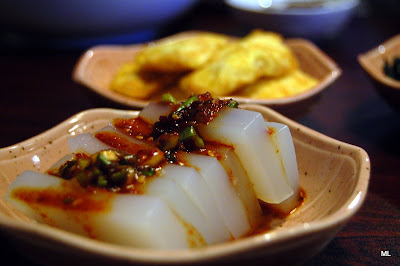
Other classic side dishes can be seen from time to time such as cold seaweed in a sweet pepper sauce, cold sauteed eggplant, daikon kimchi, marinated tofu, deep-fried sweet potato, sweetly seasoned dried anchovies, breaded cod filets, and more. Every day is a slightly different assortment of banchan, depending on her whim and passion. And with all of these side dishes, you are more than welcome to ask for seconds of your favorite banchan. Typically, Kum's homemade napa kimchi is the first to disappear, although I am very guilty of bogarting the entire mung bean jelly dish to myself at times.


The banchan really gives you the opportunity to exercise your mouth with flavors ranging from sweet to salty to spicy to crunchy to tender, and just in time to enjoy the entrees.
Of the twenty or so times that I have visited Happy Teriyaki in the last few months, I have sampled almost every Korean food item offered on the menu. Here, I will highlight three of the entrees.
This dish is probably the most impressive in three ways - presentation, flavor, and quantity. Bi bim bop is a traditional steamed rice dish that is highly known for the bounty of carefully prepared ingredients placed on top. The bi bim bop is covered with julienned carrots, spinach, burdock roots, shiitake mushrooms, soybean sprouts, bellflower roots, and beef. Each of the ingredients are individually and lightly pan-fried before they are set aside into the bowl. And to add even more excess to the bounty, she fries an egg and gently places it in the center. This, my friends, is just the beginning of your bi bim bop adventure. A little bowl of sweet and spicy soybean sauce called gochuchang (not to be mistaken for hoisin sauce) is ready to go on the side. Depending on your penchant for spice, eaters will spoon a dollop of the gochuchang onto the dish and then vigorously mix the bowl’s contents together until it becomes a brownish red mash-up of tasty goodness. I add all of it, and then some.
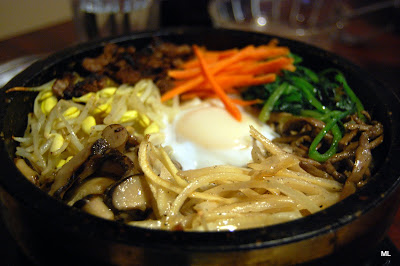
Dol Sot Bi Bim Bop
This is heaven in a spoonful. Kum offers bi bim bop two ways - regular bi bim bop (shown below) and dol sot bi bim bop. “Dol sot” refers to the large stone bowl that keeps the dish piping hot throughout the bi bim bop gorge-fest (that’s assuming you finish the whole thing in one sitting) and crisps the rice at the bottom into a crunchy treat. Growing up in California, I always passed up on bi bim bop and went for the kalbi (Korean BBQ beef ribs) or the soon doobu (tofu stew). But I truly believe that it’s Kum’s attention to each of the ingredients that makes me order this again and again. The regular bi bim bop comes in a standard ceramic bowl, which doesn’t give you the crispy rice at the bottom, but it’s still just as incredible. As my friend woefully admits, “It’s a good alternative for slow eaters like me to avoid getting your rice over-crisped.” Not only are the bowls different, but even her eggs are prepared differently. The egg is over easy for dol sot, while the egg is sunny-side up for the regular bi bim bop. Bi bim bop can be ordered vegetarian style (shown below), where she uses fresh cucumbers instead of the pan-fried beef.

Veggie bibimbap in ceramic bowl (Bi Bim Bop)
One of my all-time Korean food favorites is soon doobu, or tofu stew. It’s a dish served in many varieties that comes in a stone pot bubbling and brimming with a spicy (of varying degree) broth filled with silky chunks of tofu and various ingredients. It can be prepared with beef, pork, seafood, miso, or kimchi, but Kum offers it two ways - seafood or kimchi.
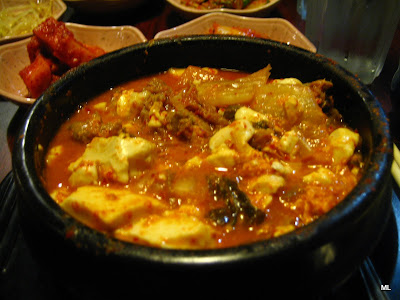
Seafood-Soft Tofu Stew
This photo doesn’t do it justice due to my poor camera quality and delayed response to take a photo several bites in (okay I lied, many bites in), although I suppose my lack of restraint is probably some indication of how well Kum prepares it here. As a seafood tofu stew, it is strewn with pieces of whole clams, oysters, shrimp, and, when it’s in good season, nice pieces of good ole’ Maine lobster. The lobster is definitely a touch of Maine, not Korea, but it just makes the stew so much better. This particular broth of “medium” spice shown above is brought on by the familiar kimchi base and is topped off with a freshly cracked raw egg, to be mixed in at table’s arrival as much as you prefer. Now you *definitely* know that the photo above is post-nibbles with egg fully immersed.
This last dish that I order time and again is Dwe Ji Go Gi Boc Um, or spicy pork with assorted vegetables. I never had this in my previous life’s Koreatown surroundings - I was essentially wired to get kalbi, Korean short ribs, every time. Good, thick pieces of juicy, tender beef still on the 1.5-inch bone, tenderized from sitting in a delicious marinade of soy sauce, garlic, green onions, Asian pear, etc. How could I dare stray away from kalbi? But my favorite major protein dish on Kum’s Korean menu is the dwe ji. Similar to kalbi or bulgogi, this meat dish comes out in a sizzling hot pan. The pan fried pork is reddish brown from the spicy red pepper sauce marinade and sits on a bed of caramelized onions. It is accompanied by a stack of romaine lettuce leaves and a little dish of gojuchang. Depending on your fancy, a concoction of a small bite of rice, a slather of gojuchang, and a few pieces of the spicy pork and caramelized onions rolled up into a lettuce leaf creates the perfect mouthful. Simple yes, but it packs a lot of flavor. The fresh crispness of the lettuce, the sweetness of the onions and the gojuchang, and then the 2-second delay of the scorch from the pork and the gochuchang. I certainly enjoy her bulgogi, which comes with the same setup. But as a person of major inclination for spice, I tend to favor the spicy pork over the subtly sweet beef bulgogi. I might come back to it when I accidentally burn off all my taste buds (which probably isn’t too far off in the future).
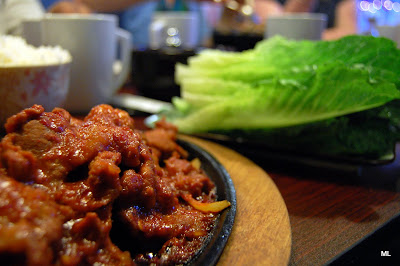
Spicy pork with assorted vegetables (Dwe Ji Go Gi Boc Um)
Although these are certainly my three go-to items on the menu, every item on the (Korean) menu has great merit. And if you are a smidge shy of the concept of Korean cuisine, ordering the Korean scallion pancake called pajun (Kum offers both regular veggie and spicy seafood versions), is certainly a first step to understanding how delicious it can be.


Spicy squid stir fry with assorted vegetables (O Jing Eu Boc Um)
Korean Seafood Pancake served with shrimp, crabmeat, octopus, and mussels (Seafood pajun)


Korean miso stew served with mushrooms, daikon radish, zucchini, potato, onions, tofu, and jalapeño (Dwen Jang Stew)
Speaking of stews, Kum’s menu does favor quite a number of hot liquid entrees and there’s a fantastic reason why you should try any one of them.
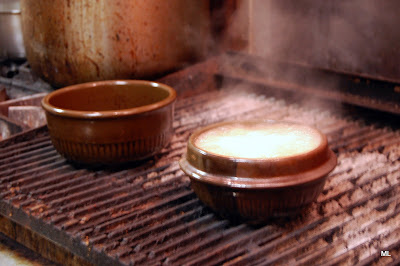
Behind the smaller pots is a 20-quart pot of simmering liquid gold. Gom tang is a rich, hearty beef stock that Kum simmers on the burner for hours and hours to harvest the best flavors and nutrients out of nice, thick bones of the ox tail. This is the base for the Korean miso stew, the tofu stews, and all the other stews that aren’t vegetarian. This is the stuff that heals you, both body and soul.
So, yes, I’ve prattled on and on for four-8.5x11 pages about the passion and love that the dedicated chef creates in each meal day after day. But yes, there are some flaws. The service is slow and it takes every inch of energy for me not to get up and help - the fiery Korean mother scolding certainly is a good disincentive to do so. Bring some patience to lunch with you because it will sometimes only be Kum running the front and back of house. Or if you’re lucky Myung will be around as he sometimes is. But it is well worth the wait because she creates each meal from scratch.
Besides, this is truly a restaurant borne out of family and love. Don’t be shy to strike up conversation with the members of the You family - you might be surprised by what you learn. Like how Myung used to play bass guitar in a popular band in Korea and loves to play music from the 60s to the good ole’ rock of the 90s on the record player sitting by the fish aquarium. Or how Kum’s mother is famous all over Korea for her super rich soy sauce that she ages for years at a time underneath her house. A teaspoon’s worth mixed in with regular soy sauce will enhance the taste to a whole new level.
There is no doubt that they still suffer from the leftover perceptions of “Happy Teriyaki.” The name doesn’t even remotely describe the wealth and depth of flavor that can be found here. At least five times a day, a customer will order Mongolian chicken or teriyaki chicken stir-fry. She’ll dutifully push out those orders, but she shines the most when she cooks her traditional home meals from Korea. But that’s all going to change soon.
A few surprises are coming around the corner - including a new menu to be revealed that is fit for all seasons and the shedding of the last vestigial piece of the previous owner to match the true spirit of the restaurant. A sneak peek of the whole menu will be here in a few weeks, but for now, a glimpse of a new menu item, bibim naengmyeon, or cold noodles in a spicy sauce.
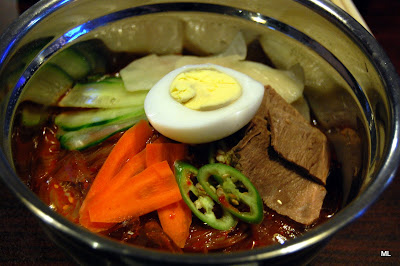
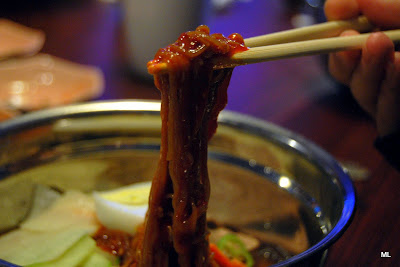
Cold noodles in a spicy sauce with slices of beef, carrot, cucumber, jalapeño, daikon radish, and a hardboiled egg (Bi bim naengmyeon)
Happy Teriyaki. What an odd misnomer for such an incredible restaurant. The restaurant’s last vestige of its former owner. For those folks not acquainted with the restaurant, they would immediately peg this Congress St. establishment as a Japanese fast food eatery, as many did when it first opened under the previous owner. And yes, they do offer Japanese food selections such as chicken teriyaki and udon noodles that are par for the course, but those among the initiated and adventurous know that the passion and heart at this restaurant is in the Korean food.
Kum and Myung You, an incredible wife-and-husband duo, moved their family from the West Coast to be closer to relatives. Myung will dutifully man the grill and deftly sear and cook his way through several of the Japanese dishes, but the soul of the restaurant lies in Kum and her Korean menu. Some reviewers in the past have mistakenly pegged these intimately crafted dishes as Korean-American food, "ready for the college crowd." I must emphasize, the Korean food here is nothing but Korean cuisine at its purest. Her family's recipes are what arrive at the table in the form of each of the banchan - obligatory Korean side dishes - and every entree in the Korean menu. Not even Myung knows the deepest secrets of her family's mastery of homemade Korean cooking.
It certainly doesn't help that I live right around the corner from Happy Teriyaki. Their street sign blazing with their hapless establishment's name can be seen from my bedroom window as if to remind me that several days have lapsed since I last ate there. And it's at this home away from home that I've found the smells and flavors that I miss tremendously.
Here at Happy Teriyaki, I've sat down to a variety of banchan, the 3-5 Korean side dishes that are complimentary with every meal, regardless of what you order. Kum's dedication to detail and flavor is evident here with each bite. Napa cabbage kimchi, a daily side dish, has the right amount of crisp in the cabbage and the perfect spice from the Korean red pepper paste. This is her homemade kimchi that you're tasting here.
And the mung bean jelly side dish, or cheongpomuk, is one of my personal favorites. Made with mung bean starch, this dish is flavored with a soy, garlic, and scallion sauce that I just can't get enough of.
Other classic side dishes can be seen from time to time such as cold seaweed in a sweet pepper sauce, cold sauteed eggplant, daikon kimchi, marinated tofu, deep-fried sweet potato, sweetly seasoned dried anchovies, breaded cod filets, and more. Every day is a slightly different assortment of banchan, depending on her whim and passion. And with all of these side dishes, you are more than welcome to ask for seconds of your favorite banchan. Typically, Kum's homemade napa kimchi is the first to disappear, although I am very guilty of bogarting the entire mung bean jelly dish to myself at times.
The banchan really gives you the opportunity to exercise your mouth with flavors ranging from sweet to salty to spicy to crunchy to tender, and just in time to enjoy the entrees.
Of the twenty or so times that I have visited Happy Teriyaki in the last few months, I have sampled almost every Korean food item offered on the menu. Here, I will highlight three of the entrees.
This dish is probably the most impressive in three ways - presentation, flavor, and quantity. Bi bim bop is a traditional steamed rice dish that is highly known for the bounty of carefully prepared ingredients placed on top. The bi bim bop is covered with julienned carrots, spinach, burdock roots, shiitake mushrooms, soybean sprouts, bellflower roots, and beef. Each of the ingredients are individually and lightly pan-fried before they are set aside into the bowl. And to add even more excess to the bounty, she fries an egg and gently places it in the center. This, my friends, is just the beginning of your bi bim bop adventure. A little bowl of sweet and spicy soybean sauce called gochuchang (not to be mistaken for hoisin sauce) is ready to go on the side. Depending on your penchant for spice, eaters will spoon a dollop of the gochuchang onto the dish and then vigorously mix the bowl’s contents together until it becomes a brownish red mash-up of tasty goodness. I add all of it, and then some.
Dol Sot Bi Bim Bop
This is heaven in a spoonful. Kum offers bi bim bop two ways - regular bi bim bop (shown below) and dol sot bi bim bop. “Dol sot” refers to the large stone bowl that keeps the dish piping hot throughout the bi bim bop gorge-fest (that’s assuming you finish the whole thing in one sitting) and crisps the rice at the bottom into a crunchy treat. Growing up in California, I always passed up on bi bim bop and went for the kalbi (Korean BBQ beef ribs) or the soon doobu (tofu stew). But I truly believe that it’s Kum’s attention to each of the ingredients that makes me order this again and again. The regular bi bim bop comes in a standard ceramic bowl, which doesn’t give you the crispy rice at the bottom, but it’s still just as incredible. As my friend woefully admits, “It’s a good alternative for slow eaters like me to avoid getting your rice over-crisped.” Not only are the bowls different, but even her eggs are prepared differently. The egg is over easy for dol sot, while the egg is sunny-side up for the regular bi bim bop. Bi bim bop can be ordered vegetarian style (shown below), where she uses fresh cucumbers instead of the pan-fried beef.
Veggie bibimbap in ceramic bowl (Bi Bim Bop)
One of my all-time Korean food favorites is soon doobu, or tofu stew. It’s a dish served in many varieties that comes in a stone pot bubbling and brimming with a spicy (of varying degree) broth filled with silky chunks of tofu and various ingredients. It can be prepared with beef, pork, seafood, miso, or kimchi, but Kum offers it two ways - seafood or kimchi.
Seafood-Soft Tofu Stew
This photo doesn’t do it justice due to my poor camera quality and delayed response to take a photo several bites in (okay I lied, many bites in), although I suppose my lack of restraint is probably some indication of how well Kum prepares it here. As a seafood tofu stew, it is strewn with pieces of whole clams, oysters, shrimp, and, when it’s in good season, nice pieces of good ole’ Maine lobster. The lobster is definitely a touch of Maine, not Korea, but it just makes the stew so much better. This particular broth of “medium” spice shown above is brought on by the familiar kimchi base and is topped off with a freshly cracked raw egg, to be mixed in at table’s arrival as much as you prefer. Now you *definitely* know that the photo above is post-nibbles with egg fully immersed.
This last dish that I order time and again is Dwe Ji Go Gi Boc Um, or spicy pork with assorted vegetables. I never had this in my previous life’s Koreatown surroundings - I was essentially wired to get kalbi, Korean short ribs, every time. Good, thick pieces of juicy, tender beef still on the 1.5-inch bone, tenderized from sitting in a delicious marinade of soy sauce, garlic, green onions, Asian pear, etc. How could I dare stray away from kalbi? But my favorite major protein dish on Kum’s Korean menu is the dwe ji. Similar to kalbi or bulgogi, this meat dish comes out in a sizzling hot pan. The pan fried pork is reddish brown from the spicy red pepper sauce marinade and sits on a bed of caramelized onions. It is accompanied by a stack of romaine lettuce leaves and a little dish of gojuchang. Depending on your fancy, a concoction of a small bite of rice, a slather of gojuchang, and a few pieces of the spicy pork and caramelized onions rolled up into a lettuce leaf creates the perfect mouthful. Simple yes, but it packs a lot of flavor. The fresh crispness of the lettuce, the sweetness of the onions and the gojuchang, and then the 2-second delay of the scorch from the pork and the gochuchang. I certainly enjoy her bulgogi, which comes with the same setup. But as a person of major inclination for spice, I tend to favor the spicy pork over the subtly sweet beef bulgogi. I might come back to it when I accidentally burn off all my taste buds (which probably isn’t too far off in the future).
Spicy pork with assorted vegetables (Dwe Ji Go Gi Boc Um)
Although these are certainly my three go-to items on the menu, every item on the (Korean) menu has great merit. And if you are a smidge shy of the concept of Korean cuisine, ordering the Korean scallion pancake called pajun (Kum offers both regular veggie and spicy seafood versions), is certainly a first step to understanding how delicious it can be.
Spicy squid stir fry with assorted vegetables (O Jing Eu Boc Um)
Korean Seafood Pancake served with shrimp, crabmeat, octopus, and mussels (Seafood pajun)
Korean miso stew served with mushrooms, daikon radish, zucchini, potato, onions, tofu, and jalapeño (Dwen Jang Stew)
Speaking of stews, Kum’s menu does favor quite a number of hot liquid entrees and there’s a fantastic reason why you should try any one of them.
Behind the smaller pots is a 20-quart pot of simmering liquid gold. Gom tang is a rich, hearty beef stock that Kum simmers on the burner for hours and hours to harvest the best flavors and nutrients out of nice, thick bones of the ox tail. This is the base for the Korean miso stew, the tofu stews, and all the other stews that aren’t vegetarian. This is the stuff that heals you, both body and soul.
So, yes, I’ve prattled on and on for four-8.5x11 pages about the passion and love that the dedicated chef creates in each meal day after day. But yes, there are some flaws. The service is slow and it takes every inch of energy for me not to get up and help - the fiery Korean mother scolding certainly is a good disincentive to do so. Bring some patience to lunch with you because it will sometimes only be Kum running the front and back of house. Or if you’re lucky Myung will be around as he sometimes is. But it is well worth the wait because she creates each meal from scratch.
Besides, this is truly a restaurant borne out of family and love. Don’t be shy to strike up conversation with the members of the You family - you might be surprised by what you learn. Like how Myung used to play bass guitar in a popular band in Korea and loves to play music from the 60s to the good ole’ rock of the 90s on the record player sitting by the fish aquarium. Or how Kum’s mother is famous all over Korea for her super rich soy sauce that she ages for years at a time underneath her house. A teaspoon’s worth mixed in with regular soy sauce will enhance the taste to a whole new level.
There is no doubt that they still suffer from the leftover perceptions of “Happy Teriyaki.” The name doesn’t even remotely describe the wealth and depth of flavor that can be found here. At least five times a day, a customer will order Mongolian chicken or teriyaki chicken stir-fry. She’ll dutifully push out those orders, but she shines the most when she cooks her traditional home meals from Korea. But that’s all going to change soon.
A few surprises are coming around the corner - including a new menu to be revealed that is fit for all seasons and the shedding of the last vestigial piece of the previous owner to match the true spirit of the restaurant. A sneak peek of the whole menu will be here in a few weeks, but for now, a glimpse of a new menu item, bibim naengmyeon, or cold noodles in a spicy sauce.
Cold noodles in a spicy sauce with slices of beef, carrot, cucumber, jalapeño, daikon radish, and a hardboiled egg (Bi bim naengmyeon)